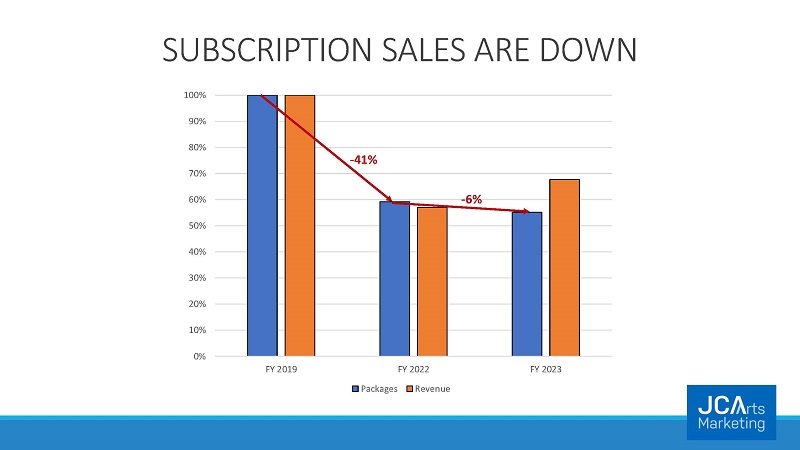4 min read
The case for rethinking your audience loyalty programme

Subscription sales have been on decline for years. A recent study compared fixed to flexible subscriptions, and discovered a silver lining.Jennifer Sowinski Nemeth, Senior Consultant & Analyst at JCA Arts Marketing, takes a closer look at the trends highlighted by JCA's subscription study. The data reinforced widespread assumptions that the pandemic closure and subsequent reopening had hastened that steady drop in subscriber numbers.
This content was first presented in February 2023 as part of The Future of Patron Loyalty, a panel event hosted by Spektrix. If you missed out, we've now published the full event online - helping you to explore what customer loyalty means for theatres, cultural venues and touring organisations in the post-pandemic world.
More flexible subscriptions offer a silver lining
On average, subscriptions declined by 41% in 2021-22 compared to 2018-19, with a further 6% drop in 2022-23. JCA used data from 28 performing arts organisations in the US to reach these figures. They varied by organisation type (music organisations tended to fare a bit better, and theatres a bit worse), but across the board, there’s no doubt that performing arts subscription numbers have been one of the many pandemic casualties.
However, there is a silver lining! In that same study, JCA Arts Marketing compared sales across different package types, to see how traditional fixed packages were faring compared to other styles of subscription. To account for the many variations in subscription packages across the industry, we grouped subscriptions into four primary models:
-
Fixed Subscriptions:
A traditional package, where the subscriber purchases a fixed set of performances, with seats assigned at the time of purchase. These could be full-season or partial-season subscriptions. -
Choose Your Own:
A subscriber selects their own set of performances with a combination of dates and seats, all chosen at the time of purchase. -
Ticket Credits:
A subscriber purchases a set of credits or vouchers that can be redeemed for tickets to a performance. They can be redeemed at the time of purchase or at a later date. -
Pass/Membership:
A subscriber/member pays a fixed amount either monthly or yearly, and can attend performances as often as they’d like.
We then compared sales from the 2021-22 season to the 2022-23 season, to see how these different types of packages have sold since reopening. Fixed subscriptions declined between these two years, with the number of packages sold dropping by about 9%.
But here’s where we get some good news. Across organisations who offered the option in both years, Choose Your Own packages sales increased by 43%! Ticket Credit packages and Pass/Membership options saw an even bigger increase, with the number of these types of packages sold more than doubling between 2021-22 and 2022-23.
This data suggests an incredible opportunity for arts organisations to take a hard look at their loyalty programme offerings, through the lens of what their audience is actually looking for. While traditional fixed subscriptions continue to decline, there is a strong appetite among audiences for more flexible options that fit their 21st-century, post-pandemic lifestyles.
We get an additional clue that these more flexible options work better for audiences through attendance data. In 2018-19, pre-pandemic, fixed subscribers attended and used their tickets about 80% of the time. In 2021-22, that attendance rate dropped to 68%. On the other hand, more flexible packages including Choose Your Own, Ticket Credits, and Pass/Membership had an attendance rate of 85-88% in 2018-19. Attendance for these packages also dropped in 2021-22, but by a much smaller amount, to 76-81%.
So again, we see that flexible packages are more appealing to audiences, and result in higher attendance rates. This suggests that performing arts organisations would be wise to consider how flexible options can be incorporated into their overall audience loyalty strategy, and what adjustments would help align their offerings with what their audience is looking for.
Traditional fixed subscriptions have endured for so long in large part because of the many benefits they offer organisations; they offer an influx of cash at the start of the year, guaranteed sales even for productions that might not be as popular, and the ability to front-load longer runs.
On the other hand, there are some downsides to fixed subscriptions that are becoming harder to ignore. Traditional subscriptions bind the organisation to an operating model that requires pre-determined run-lengths, a specific schedule of performances, and a set amount of programming each year. They also tie the organisation to programming that will generally appeal to subscribers, because as new subscribers have become harder to find, an outsized emphasis has been placed on retaining existing subscribers. Perhaps most importantly, fixed subscriptions can create a substantial equity problem among ticket buyers. Subscriptions cater to people who can spend a large sum of money long before the actual performances and who are able to plan that far ahead. Traditional subscribers also typically get the best access to seats, the most perks, and therefore the best experience. This can literally side-line other members of your audience who don’t have the means or opportunity to become traditional subscribers.
Finding the right loyalty model for your organisation
Making changes to an existing loyalty programme may feel a bit daunting. As you’re getting started, here are a few important things to consider:
First, use the full creative strength of your organisation. Subscription decline is not just a problem for the marketing department. It’s a problem for the whole organisation, down to the artists and crew who do the work to put on great performances. Fewer subscribers leads to less revenue, which leads to less budget to spend on productions. And the artists on stage will be the ones to feel it most when audiences are small. So, use all the resources in your organisation to address the issue. You never know if a lighting designer, stage manager, or dramaturg might have a great idea to make the audience experience a little more special.
Second, it’s critically important to do your research. Making changes to a loyalty programme requires a lot of work, especially if you start off down the wrong path. Doing the research up front to understand what your audience wants and what will motivate their loyalty will ultimately save you time and money. There are many ways to do this research (JCA Arts Marketing is particularly partial to conjoint analysis), but however you go about it, make sure to do this research up front so that you’re not wasting precious time and resources on an approach that isn’t going to work for your organisation.
Finally, engage your peers in the industry. There are many organisations out there who are already doing creative and innovative things, so don’t be afraid to reach out to your colleagues at those organisations and learn from what they’ve done! You’ll also find that many of your peer organisations are in the same boat and looking to answer similar questions at their organisations. Consider whether its possible to pool your resources and do research together. Doing research with other organisations can decrease the individual burden, while also providing extra insight that you wouldn’t get if you went it alone.
Whatever the path forward, be creative and forward-looking. Traditional subscriptions may be on the decline, but there are new and exciting possibilities on the horizon!
This content was first presented in February 2023 as part of The Future of Audience Loyalty, a panel event hosted by Spektrix. View the full recording and slides below.
THE FUTURE OF AUDIENCE LOYALTY
Jennifer Sowinski Nemeth is Senior Consultant & Analyst at JCA Arts Marketing.
Read JCA's full Subscription Study
Sign up to the JCA Arts Marketing newlsetter


